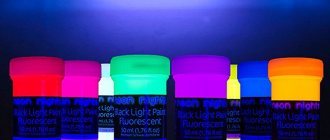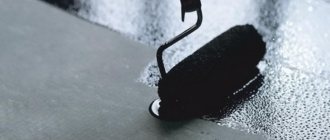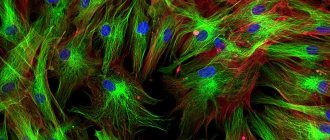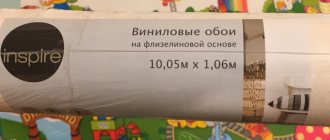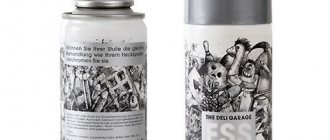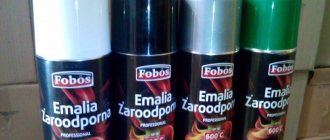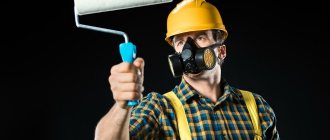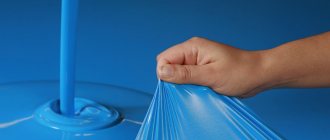The construction technology market does not stand still and periodically surprises consumers with its new products. One of them is ultraviolet paint, invisible in daylight, which is widely used by decorators and designers today.
Its name involuntarily evokes fantastic associations, although in fact it is a completely ordinary material for interior decoration.
In the photo - decorating the premises with luminous paints
Areas of application
Paint with a reflective effect is used for marking or decoration purposes, respectively, where reflection of light is required.
A nice feature of this material is that it dries quickly even in harsh climatic conditions. To make the reflection effect more pronounced and lasting, a primer is usually used before applying paint. If reflective material is used for decoration, then it is recommended to additionally apply a colorless varnish on top of its coating - this will not only consolidate the effect of light reflection, but also give the surface a glossy texture. The most widely used is aerosol reflective paint in cans. This is due to the fact that its application does not require much labor, special skills or significant time investment. The main advantage of aerosol varnish is that it is ready for use immediately after purchase. But regardless of the external form, be it a can or a jar, compositions with the property of “glow in the dark” are used to solve many problems, including:
- creation of markings near schools and on the territories of enterprises;
- applying markings to vehicle elements;
- painting helmets or uniforms of motorcyclists and cyclists;
- decoration of facades, for example, facing tiles, panels or ordinary concrete surfaces;
- designation of road signs and highway surfaces;
- decorating the premises of private houses, clubs, bars and various entertainment venues;
- creating works of art - from glow-in-the-dark paintings to spectacular body art (in the latter case, special coloring compounds are used that meet a number of hygienic standards).
The increasing popularity of reflective varnish is influenced by the fact that roads are filled with an increasing number of cars. Thanks to the varnish, movement on and near roads in the dark becomes safer for both pedestrians and drivers. Therefore, light reflective coating becomes not a luxury, but a concern for lives. In order to understand this more deeply, it is enough to imagine how the situation will change if the road, its markings and signs cease to be noticeable.
An advantage to all of the above is that a coloring mixture with a similar effect can be easily created with your own hands at home. And, of course, you can use it for your own purposes, not necessarily related to road traffic. There's nothing complicated about painting simple, portable objects such as children's toys - it will give the child the opportunity to look at them in a completely new way under the cover of darkness. The main thing is that because of the interest he shows, you don’t have any difficulty sending your baby to bed. Another option is to make a luminous drawing on the wall so that the child is not afraid to sleep in the dark.
Handmade production
It’s possible to make reflective paint at home , although even in this case you won’t be able to do it without going to the store. To work on its creation you will need:
- respirator, safety glasses and gloves (remember that safety comes first);
- phosphor (element with a reflective effect);
- colorless, completely transparent varnish;
- solvent;
- glass or ceramic dishes for convenient mixing of all ingredients.
It is not difficult to find all of the listed components in a ready-made set in a building materials store, with the exception of protective equipment (however, this does not mean that they should be neglected). Having collected all the components, you can begin preparing the glowing mixture:
- Pour clear varnish into the bowl;
- Pour in powdered phosphor, trying to achieve a ratio where there is 70% varnish and only 30% phosphor;
- Add just a little solvent to the resulting mixture. Its volume should not exceed 1% of the total mass of the mixture;
- Mix the entire solution thoroughly.
In fact, it is easier than it seems, since it is enough to read the instructions included with the components or ask the building materials seller for advice. One has only to add that depending on the surface that you are going to paint in the future with the prepared mixture, the compositions will differ.
Composition and characteristics
Any reflective varnish owes its “magical” properties to a special pigment in the form of a ball, which is mixed with a transparent varnish. The task of pigments is reduced to the following: beams of light entering them are reflected, as a result of which the painted surface glows.
It is generally accepted that the ideal proportion of pigment balls and a binder in the form of varnish for working with an aerosol spray gun is 1:3 (where 1 part is pigment, and 3 parts are dye). However, some people mistakenly believe that the more light-returning balls, the better the glow effect. But that's not true. There is a clear proportion, tested by the hands of professionals and many years of experience, which is better to adhere to. If dilution is necessary, use toluene or xylene.
The composition of varnishes with a glow effect differs in the basis of each of them, and you should focus on it before purchasing and carrying out work. The varnish base must be chosen depending on the type of surface to be coated: concrete, plastic, metal, wood, glass or road surface.
The packaging of the painting product must contain detailed information about the composition and surfaces for which it is intended. For example, when working with concrete, you should give preference to acrylic-based paint, and when working with metal, you should give preference to alkyd-based paint. For the reflective balls themselves, it does not matter what base they are mixed with, be it alkyd, polyurethane or acrylic varnish - their properties do not change.
The average consumption of coloring materials with a reflective effect is 250 grams per 1 square meter. The average drying time at a temperature of 22 degrees Celsius, as a rule, does not exceed 60 minutes. Prices for both aerosol products and those applied with a brush vary greatly, making it difficult to give them an unambiguous assessment.
Ultraviolet radiation
The natural and most intense source of ultraviolet waves is sunlight. When passing through the atmosphere, only ultraviolet radiation UVA with a wavelength of 315-400 nm (only a tenth is absorbed by the atmospheric layer) and a small part (about 10%) UVB with a wavelength range of 280-315 nm reach the earth's surface.
The level of UV radiation can be affected by:
- The position of the Sun at a certain time of day and season.
- Surface height above sea level.
- Degree of cloudiness. Light clouds practically do not block UV rays.
- Thickness of the ozone layer.
- Properties of a surface to reflect ultraviolet radiation.
In the shade, UV radiation is reduced by half or more, depending on the reflective properties of surrounding objects that are directly exposed to ultraviolet radiation. Snow is the most reflective and can reflect up to 90% of UV rays.
Manufacturers
There are many manufacturers of glowing paints on today's market, and many of them produce quality products.
One of the most worthy brands is Revell. This brand was created in America in 1943. At first, his products were plastic toys and doll furniture. The company expanded, merged with others, including European companies, and the company's product range grew. Revell began producing prefabricated models of cars, ships, and airplanes. The product was a huge success. In addition to model kits, the company has launched the production of all the necessary accessories for assembly. Among them were paints, brushes, sprayers.
Revell is constantly developing, studying global experience, modernizing and expanding production. Taking care of her clients, she develops interesting programs with bonus points and promotions. Bonus points can be used to pay for some purchases. The company's consultants are always in touch and help customers choose goods that will be delivered to any corner of Russia.
The line of luminescent paints is represented by water-based acrylic compositions. Environmentally friendly materials are used for their production. They are suitable for decorating children's toys. When applied, a thin, even layer is obtained, which dries quickly and makes it possible to apply the next layer.
The paint has no pungent odor and is not flammable. If necessary, you can easily mix different tones. Luminescent yellow, silk-matte red, and matte orange paint look especially beautiful.
Some companies not only produce paint, but also produce luminous products. Noxton is among the leaders. It offers the widest selection of paint compositions of various types (luminescent, fluorescent, reflective) for various surfaces and for a variety of purposes.
Noxton paints are economical and safe, have a very long service life, and high-quality dyes are used for their production.
Noxton also offers a large range of finished products (more than 40 directions), among which you will find:
- luminous self-adhesive film;
- safety signs and vests;
- nail polish and hair gel;
- souvenirs;
- paintings;
- items for interior decoration;
- items for different areas of design.
It has proven itself well, existing since August 2011. The company produces and sells luminous paint and aerosols, special pastes and liquids for mirrors and glass. The company also sells luminous products that can transform different rooms.
One of the areas of her activity is the production of luminous paintings. They are suitable for any interior and make it mysterious at night. "Fairytale World", Magic Crow, "Leopard" are full of charm and magic.
The paintings can be charged by any light or heat source in a few minutes, and they will glow for 10-12 hours. The glow can be blue or green. Manufacturers promise this function to work for up to 100 years.
Even more options for using glowing paint are presented in the video below.
Rating of the best brands of UV paint
Today, a variety of brands are engaged in the production of such paints. Popular brands include:
- VAN SON (Netherlands);
- MEGAMI (Japan);
- Excure (Belgium).
See also
6 suitable types of paint for a concrete fence and step-by-step application
Peculiarities
Fluorescent paints also emit light during the daytime. However, in the dark their light becomes 3 times brighter and more saturated. For this reason, this paint is often chosen for night decoration and various types of markings. To make surfaces coated with this paint look stylish even during the day, you can use colored fluorescent products.
They can be white, blue, green, red, brown or light blue. Transparent colors will be almost invisible during the day. This dye will not glow on its own. When exposed to ultraviolet rays, its bright glow will increase tenfold.
If you don’t know how fluorescent paint differs from its luminescent counterpart, you should take note: the latter has an independent illumination effect. The duration of this effect can last up to 10-12 hours. Over the course of a whole day, painted surfaces absorb light; with the onset of darkness, they begin to glow autonomously. This difference allows you to accurately select the right type of paint.
There is also reflective dye. It acts as a reverse reflection of the light flux: as soon as the light hits the painted surface, the rays are immediately reflected at a distance of 200 - 250 m. This paint is selected to increase safety on the roads.
Different types of fluorescent materials are suitable for coloring:
- metal products (they can be used to cover car rims, road signs, and various objects);
- different fabrics (depict designs on clothes, use for advertising purposes);
- glass and ceramic products (this could be tableware or stained glass painting);
- the human body (can be found in body art) and on the leaves of ordinary plants;
- wood (you can paint fences, decorate gazebos, window and door openings);
- stone and concrete (painting walls, garden paths, city alleys, building facades);
- plastic (products made of PVC, polystyrene and other plastic materials).
In addition to the ability to glow beautifully, fluorescent materials have other characteristic features. Among them there are both advantages and disadvantages. Let's look at the key points.
Low light fastness
Fluorescent paints can fade in a matter of months when exposed to light (if used externally). To make the dyes fade more slowly, a modifier is introduced into the product, which absorbs UV rays. In addition, the coating with already applied paint can be painted over with transparent varnish. But the brightness of the paint will be reduced.
Loss of quality due to incorrect tinting
A fluorescent coloring product will become extremely unstable after unsuccessful tinting. To give the surface durability, it is better to immediately buy ready-made material in the desired color.
Grain
Since the pigment grains are too large, they will not allow you to achieve a completely glossy finish. To solve this problem, the dye is applied in 2 layers or painted over with varnish.
Fear of excessively high temperatures
Fluorescent paints and varnishes disintegrate at temperatures of +150 – 250 degrees C. They completely lose their ability to glow brightly.
You only need 15 minutes of bright daylight or artificial light to charge the applied paint for 8 full hours of use. The process of light accumulation is a completely continuous cycle. Product manufacturers guarantee that their luminous paints will work for at least 30 years.
Advantages and Disadvantages of UV Curing
The UV curing method is considered environmentally friendly. Other advantages of this technology include the following:
- short drying time;
- economical consumption;
- possibility of application in parts - in this case it is permissible to paint a certain part of the surface;
- the possibility of reusing leftover paint or drained coating;
- high degree of strength and durability of the painted surface;
- the possibility of applying a thin layer to obtain a high-quality coating;
- low level of explosion hazard;
- harmless to the human body.
It is important to take into account that such materials and the technology that implies their use have certain disadvantages. Key disadvantages include the following:
- poor payback when used on automatic lines - this is only possible with large production volumes;
- high price - UV-curing dyes are more expensive than folic or solvent dyes;
- long drying period when painting non-flat surfaces;
- the need to slow down the curing process to obtain a high quality coating;
- the impossibility of eliminating defects on a painted surface - these include drops or streaks.
See also
Types of primers for bathrooms and rating of the best brands, how to apply
Fluorescent paint
Many people can answer the question of what kind of paints these are. Indeed, fluorescent paints belong to decorative paint and varnish material, which has a unique reaction to the influence of light flux. Products coated with this composition are visible in any lighting. Moreover, at night they are much brighter than in the daytime. Professionals emphasize that the glow is almost twice as intense.
The high demand for similar materials is naturally explained by the unusual effect and therefore the paints were quickly noticed.
Fluorescent luminous paint
The variety of paints offered has a wide range. You can choose from white, brown, red, blue, yellow, green paints. Interestingly, they can be visible or invisible. Invisible paint has the peculiarity that it is almost impossible to see it in the daytime. It only appears when exposed to ultraviolet rays.
Visible paint is easy to distinguish, however, when exposed to sunlight, the glow intensifies.
The most common fluorescent coloring composition is acrylic, the base of which is water-based. The composition includes a dye, a binding element (acrylic polymer emulsion) and water prepared in a special way. Those who have used this composition note the uniqueness of the product.
The advantages of the material include:
- Versatility - can be used both indoors and outdoors.
- Ease of use - when performing work, a spray bottle, brush, paint sprayer or roller is enough.
- Saturation of the painted surface - additional protection from adverse weather conditions can be achieved using a polyurethane-based varnish.
- It fits well and economically on the surface.
- Dries quite quickly.
- Impeccable consumer properties - do not tarnish, the color does not lose color under the influence of sunlight.
- Do not harm human health.
- A diverse range of applications - you can paint paper bases, fresh flowers and wood, concrete and stone surfaces, plastic and metal.
The use of dyes with fluorescent special effects is quite widespread.
The unusual property of the material can be successfully used as:
- Marking – designation of signal strips and signs on transport.
- Painting of various objects - equipment, road signs, "beacons".
- Marking of pipeline fragments, machine tools, equipment that have hazardous areas.
General disadvantages
Unfortunately, coatings cannot fluoresce forever, since they have rather poor resistance to direct sunlight. You can avoid rapid fading by using protective agents, such as clear varnishes.
When purchasing such a composition, it is important to make sure that it does not have matting properties, which will significantly reduce the glow effect. The texture of the fluorescent dispersion does not allow achieving a glossy surface finish. When such a need arises, you can resort to the method described in the previous paragraph. The material does not apply to heat-resistant compounds
Destroys at a temperature of +100-150 °C.
Kinds
Since there is no official classification, the type of paint can be determined not only by the active pigment, but also by the surface on which it is applied. Different compositions can be used for the same surface.
Phosphor paint is suitable for coating various materials. It can be used to apply designs to metals, fabrics, glass, wood, concrete, and plastic. It quickly accumulates light energy and then releases it over many hours, providing a beautiful phosphorescent glow.
Since prolonged contact with phosphorus can cause nausea and more severe poisoning, in modern paints phosphorus is replaced with a phosphor that acts in a similar way.
The phosphor is a phosphorescent powder, so paint with it is called phosphorescent.
Also, paints in which the pigment can accumulate both solar and electric light and then release it are called luminescent. The color at night may be different from the color the paint is during the day.
The undoubted advantage of luminescent paints is their harmlessness. And since they are made on the basis of varnish, they have another remarkable property: by creating a film on the surface to be painted, they protect the object from humidity and other adverse environmental influences.
For some people, luminous floral paints are of particular interest. They are designed to create a glow effect on fresh flowers.
It can be used to treat any parts of plants: petals, leaves, buds. And it will even extend the life of cut flowers.
It can be applied in any way. During daylight hours it will look like a light white coating. Any light source will “charge” it.
A slightly different type is fluorescent paints. They can be any color and look like regular paint. Neither day nor night they differ from ordinary coatings. They require a source of ultraviolet light to glow. They can be used on wood, concrete, paper, metal or plastic. In order for their effect to appear, one layer is enough.
The base for fluorescent compositions can be of any color, they can even be applied to other designs made by conventional means. Fluorescent paints do not harm health, so they can be used in homes and places where large numbers of people gather.
Some modern manufacturers are mastering the production of compositions in which the glow effect appears as luminescent with gradual attenuation and as permanent when irradiated with ultraviolet light.
Manufacturers produce phosphorescent paints in different containers: cans and spray cans.
Aerosol paint is more popular due to the following properties:
- it is easy to use;
- this is a ready-made composition, there is no need to add solvents or other substances to it;
- you can quickly paint a large surface with it;
- it dries quickly.
UV-curing paints: properties and features
When using UV-curing paints, special lamps are used. With their help, it is possible to fix the applied substance. Some materials in this category are highly toxic. Therefore, they are prohibited from being applied to food packaging. However, after drying, such materials do not release solvents, as solvent compositions do.
However, it is important to consider that the use of lamps is accompanied by the synthesis of ozone. When the concentration in the air increases, this substance can become quite toxic.
Ultraviolet paints differ from simple compositions that contain solvents in their ability to dry quickly. Other features of this type of material include the following:
- rigid structure;
- resistance to moisture;
- sticky and viscous consistency;
- no rapid abrasion;
- drying only under the influence of ultraviolet light.
Composition and curing methods
Paints that harden under the influence of ultraviolet radiation contain the following components:
- Dye or pigment – gives the coating a specific shade.
- A special binding component in liquid form helps transform the material into a solid film. It hardens under the influence of ultraviolet radiation.
- Photoinitiator - takes part in the chemical reaction of solidification.
- Ultraviolet hardener is an oligomer. This group includes viscous components that acquire a solid consistency under the influence of ultraviolet radiation.
- Monomers are vegetable oils and solvents.
- Additional components and wax.
Essentially, UV-curing paint is a powder that contains curable polymers. As it warms up, the composition melts, forming a durable film on plastic, paper or wood.
A distinctive feature of this type of paint is that on a white surface they are fixed quite quickly, while on a dark surface the polymerization process occurs much more slowly.
The fact is that a light background repels ultraviolet radiation, and a black background absorbs it.
The final stage of applying ultraviolet dyes is drying. The dispersed medium during drying of dyes and varnishes is air. The formation of a film is due to the fact that the polymer solid fragments that are present in the material form a strong bond. They first melt and then acquire a hard texture. When using the material, it is first heated to +115 degrees. Thanks to this, it dries within a few minutes.
See also
Drawings with acrylic paints on fabric for beginners and top 6 painting technologies
Scope of application
The unique characteristics of the material allow it to be used in various fields. Ultraviolet dyes are produced for different types of printing - digital, screen or offset. The properties of such materials help to implement non-standard design solutions.
Expert opinion
Zakharova Irina Yurievna
Cleaning professional with 15 years of experience. Our best expert.
Ask a Question
The scope of application of ultraviolet dyes is not limited to the production of printed products.
They are often used in furniture production and interior design. Such materials allow you to print on cardboard and paper. They can be applied to glass, metal, wood, and ceramic surfaces.
Quality and durability of the coating
This type of paint contains curable polymers. During drying, they form a film of high strength. Moreover, the quality characteristics of the coating do not depend on its thickness.
UV-curing paints have the following features:
- uniform application;
- no spreading.
The quality of the coating depends on the following factors:
- dye composition - it includes pigments, solvents, resin, synergetics, photoinitiator;
- surface type;
- conditions for applying the dye;
- radiation dose;
- the type of ultraviolet device used;
- distance between lamps and coating.
General recommendations for the use of fluorescent paint
The application of luminous enamels is no different from any other type of painting work. Of course, the specifics of application are influenced by the composition, purpose and type of surface to be painted.
There are several general recommendations:
- purchase of standard equipment and additional materials: brushes, rollers, spray gun, protective equipment, solvent;
- surface preparation: remove dirt, dry and degrease;
- paint preparation: stir the composition until smooth, add thinner/solvent if necessary (according to the instructions);
- application of the material: usually, it is recommended to apply the fluorescent composition in 2-3 layers to form a high-quality and durable coating. Each layer needs to be allowed to dry a little.
Conclusion
So, now you know the answer to the most popular question - does fluorescent paint glow in the dark or not. By choosing a high-quality source of ultraviolet radiation, you can create a unique interior, as well as give an unusual look to your own clothes, car or even hair. Go for it!
Application technique
Most often, such paints and varnishes are applied to facade parts and various protruding parts of structures. Reflective pigment is the main distinguishing feature of their composition, which eliminates the need to use additional decorative layers. All that is required for liquid formulations is to mix them first. Before using materials in tubes or cans, you don’t even need such a small thing - they are ready for use from the very beginning.
But first, take care of the surface you are going to apply paint to. As with any painting and finishing work, you need to remove any foreign elements from the surfaces, such as dust, rust, grease stains and dirt
If you are going to apply paint to the road surface, then pay attention to pieces of earth and clay - they need to be removed to the base
If the area to be painted is small, then it is advisable to use aerosol reflective varnish in cans. Otherwise, you will need any of the common painting tools - a brush, roller or spray gun. Moreover, the latter is used for working only with fairly liquid compositions. There are then 3 options:
- Mixing a varnish base with reflective balls and color. This method is not designed to produce a thick consistency and can effectively use a paint sprayer;
- The base in the form of varnish is applied to the surface separately from the entire composition, and pigment balls of the desired color are scattered from above using a sieve onto the varnished areas. Excess balls are removed (a jet of compressed air does an excellent job of this). Half of the remaining pigment is not painted over, that is, the previous layer of varnish serves as its adhesive base. This method is used in large-scale road markings;
- White varnish is applied to the surface like a primer, and after it dries, a colored reflective layer is applied.
It is recommended to carry out all work with reflective paint at low air humidity and room temperature. To increase the resistance of the reflective coating to wear, the composition additionally includes quartz sand (with a grain size of no more than 0.2 millimeters and in a proportion of up to 1/100 of the total mass).
Types of paints
Today, there are two widely known types of coloring mixtures with the effect of light reflection. All of them, at first glance, are very similar, but each product has its own advantages, operating conditions and its own mechanism of the glow phenomenon. Before purchasing it, it is better to familiarize yourself with information about each of these types.
Luminescent varnishes
Luminescent varnish accumulates light from the sun and artificial illuminators, and then reveals it in the dark for 8-12 hours. It reflects soft, eye-pleasing light without even requiring additional ultraviolet exposure. Thanks to the phosphor, light energy accumulates throughout the day, working autonomously in the dark and thereby allowing partial savings on electricity. As a rule, the colors issued are green, blue and milky.
Due to the fact that the pigments of such varnishes sometimes contain harmful substances, the use of luminescent compounds is limited. There is an opinion that they should not be used in bedrooms, children's rooms and kitchens. This is not always justified and relevant only if phosphorus acts as an accumulator in the composition - in this case, it is better to use the coloring material only in outdoor decor, outdoors.
Fluorescent compounds
Paints and varnishes of this type work somewhat differently: their coating does not accumulate light energy, but exhibits a glowing effect only when rays of sunlight or artificial light hit it. An example of this effect can be seen on the road at night, where road signs, indicators and markings begin to glow when hit by headlights.
Fluorescent dyes are used not only for roads, but also for clothing. For example, in some cases they are used to paint work clothes. This type of paint is also in demand when decorating the premises of entertainment establishments, where when ultraviolet lamps are turned on, the painted interior takes on an extraordinary appearance.
Effect on the body
As for luminescent paints , their factory production is a complex technological process, which has its own costs. Pay attention to the presence of phosphorus. If it is included in the paint and varnish material, then it is better not to use it indoors or on clothing; at most, give it a place in the yard (preferably where children do not play).
The glow of most modern reflective materials is due to the formation of defects in the crystal structure of their substances. These defects are formed by adding activator impurities. At the same time, no radioactive elements, as was once upon a time, are added to reflective paints. Light radiation occurs in the visible spectral range, which is why they do not harm human health.
There are even specific luminous compositions for the body that are applied directly to the skin, but they must meet hygienic standards and must also be accompanied by special safety certificates. Therefore, it is impossible to give a definite answer about the safety of coloring products - you must always proceed from the composition.
Volume
Spray paint is best suited for the job: if all the available material is not used up immediately, it will be stored in a can until the next use. At the right time, you will be able to again implement new original ideas for designing a luminous image. The volumes of this paint in aerosol packaging for use for different purposes can vary from 100 to 520 ml. You can purchase paint in cylinders of 140, 150, 200, 240, 300, 340, 400 ml.
It is difficult to answer exactly what surface area can be painted with one aerosol product of a certain volume: paint consumption depends on a number of factors
It is important which company produced the paint. Has the meaning:
- hiding power of the product itself;
- original surface color;
- paint absorption capacity;
- presence of primer;
- experience in using aerosol paint.
- uniformity of application.
- paint tone (the lighter the shade, the greater the dye consumption);
The approximate consumption of such a can, according to the manufacturer's label, is per 1 sq. m. approximately 200-300 ml.
What you need for painting
During printing, it is important to ensure optimal climatic conditions:
- temperature at +18-24 degrees;
- humidity – 50-60%.
Curing depends on the choice of UV emitter. They can have the following varieties:
- mercury lamps;
- LED, electrodeless, quartz devices;
- LED lamps;
- fluorescent, xenon devices.
When choosing a device, it is important to consider that the frequency of its emission must coincide with the frequency of absorption by the photoinitiator. This component is responsible for the required dose of ultraviolet rays and the ability of dyes to react.
For the purpose of polymerizing powder paints, it is permissible to use wide-spectrum lamps. But they have some disadvantages:
- toxicity;
- high energy consumption.
Scope of application of luminous paints
There are many creative industries that use luminous materials. Let's look at a few of them.
- Machine numbers. In order to decorate your car, you can use this material. The application process to the surface is very fast. The finished coating will glow for two hours after finishing work. There are no guarantees for the operation of the material, since it physically cannot deteriorate. In daylight, license plates will be of normal color, but only when entering a dark room will they acquire a beautiful green-blue color. The contents of the number (numbers, letters) stand out well.
- Machine disks. This is the second way to make your car special. The work of covering the caps consists of a couple of stages. First of all, the surface is cleaned of dirt or dust, covered with a primer, and luminous paint is applied to the dried primer. To protect the surface you need to open it with a special varnish. After finishing the work, it should take a day to get the result.
- Glass decor. One popular use is the use of paint for glass, porcelain, and ceramics. If we look at it specifically, these could be vases, glasses, glasses or ashtrays. Such items will be an excellent gift or an unusual nightclub interior.
- Glowing paint for flowers and plants. Luminescent paint is a safe material for both people and the environment. To surprise a girl or woman, cut flowers can be covered. During the day they will look like ordinary ones, but at night they will pleasantly surprise you with their unusual color.
- Used in textile or fabric factories, silk-screen printing.
- Design of a room, building, premises. You can transform an old building or room in an unusual way. It can be applied to ceramic tiles, wallpaper, walls painted with regular paint, plastic or wooden baseboards. For example, you can paint a starry sky on the ceiling, or Christmas trees on the walls before the New Year. Popular are artistic paintings, LED materials, watches, leather belts.
- You can complete the drawing (shapes, flowers) or just the outline through a stencil.
- They are also used for safety signs, clothing, decorative stones, children's souvenirs, nail polish, paintings, business cards, body painting, tattoos. They can be used to draw stained glass designs on paper or style. Used for makeup.
Glow in the dark paint
Kinds
Today, fluorescent paint is presented on the market in four main types:
- Acrylic enamel for use in room decoration. Often used when updating or changing the interior.
- Acrylic enamel, which is intended for painting house facades.
- Aerosol paint containing urethane and alkydane. It is a universal paint coating. This type of coating is produced in cans that are convenient for use.
- Invisible colors. They are almost invisible on light surfaces, but this is during the daytime. At night, they acquire a whitish tint in the form of chaotic stains. They are often used by designers in exclusive projects. This paint has also found application in illuminating road signs.
Enamel for decorating interior items can be applied to almost any surface, be it wood, plasterboard surfaces, paper, stone. The exceptions are plastic and metal surfaces.
The color shade of acrylic enamel is determined by its composition, which includes acrylic as a base and luminescent pigment particles. New shades are obtained by mixing existing colors.
The paint does not have an unpleasant pungent odor. It is not toxic. The disadvantages include low moisture resistance, so it is better not to use it in the bathroom or swimming pool.
Acrylic enamel, intended for painting building facades, is very resistant and can withstand different temperatures. It does not fade and is quite resistant to cleaning and disinfection agents. Cleaning a house painted with this enamel will not be difficult.
Facade paint is odorless. It has excellent vapor permeability. It fits well on concrete surfaces and galvanized metal, which cannot be said about many other types of paint and varnish coatings.
Aerosol paint, which belongs to the class of universal coloring agents, has a wide range of uses. They are used for interior and exterior work. The process of applying this paint is simplified due to the fact that it is produced in small cans. Aerosol paint can be applied to many types of surfaces:
- glass;
- plastic;
- tree;
- wall surface.
They are ideal for use in the bathroom, swimming pool, toilet, as they have the highest vapor resistance.
Invisible paint is a very popular type of paint coating. She has a rich range of colors. Ordinary white walls or ceilings during the daytime magically turn into masterpieces of designers and artists at night, shining with different colors. All this thanks to ultraviolet radiation.

